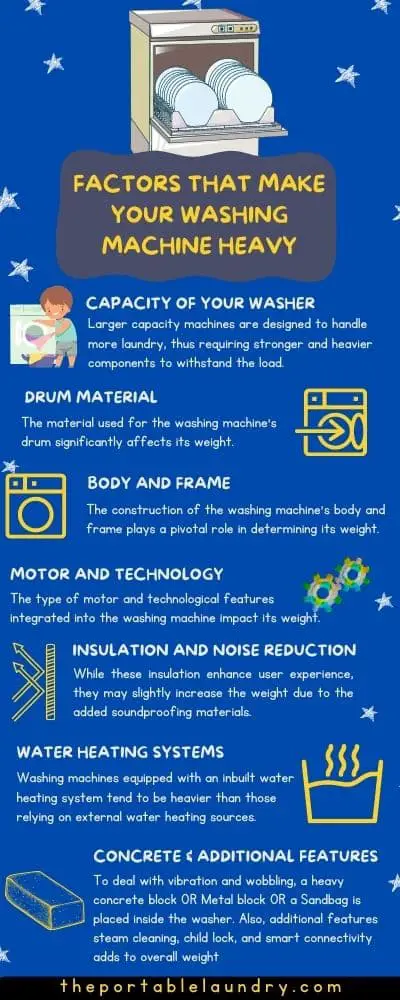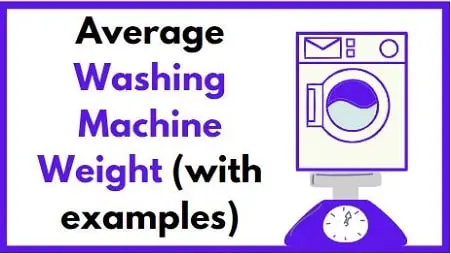How much does my Washing Weigh? This can be a complicated question depending on the type and model of your washing machine.
The average weight of a large capacity washing machine is about 230 pounds. Whereas a medium-size washer can weigh anywhere between 150-180 pounds. As you load up the washer with laundry, that weight obviously changes.

With that said, the weight of your washer may vary significantly depending on the type of washer and model.
If you are using a small washer, the weight will be considerably lighter than an average large-sized washer.
The weight of your washing machine can affect how easy it is to move.
Note: Typically a front-loading washer will weigh more than a Top-loading washing machine but this is not a rule and there will always be a few exceptions
Table of Contents
Why Does Washing Machine Weight Matter?
Washing machine weight is an important consideration for a number of reasons.
First, a heavy washing machine is more likely to damage your floors over time, as there are chances that you will be moving your washer around may be to clean or perform maintenance activities.
Second, a heavier washing machine will use more energy to operate, resulting in higher utility bills. Heavy washers in general are large which also means they require more power to operate.
Finally, it’s very difficult to move your washer around which also means a lot of hassles when you shift your house.
It is important to carefully consider the weight of your washing machine before making a purchase.
By taking the time to understand the importance of washing machine weight, you can make sure that you select a machine that will be durable and efficient.
Try to strike a nice balance between load handling capacity and weight. If you have a large family, it may be worth it to invest in a larger and heavier washing machine.
But if you live alone or have a small family, it might be better to choose a smaller and lighter machine.
Why Are Washing Machines So Heavy?
Washing machines are so heavy because they need to be able to handle a lot of weight. This is necessary in order to ensure that the machine can properly clean clothes. The extra weight also helps to keep the machine stable during operation.
The key material OR the component that makes your washer heavy is concrete.
Yes, that’s right Concrete.
Concrete Blocks are placed in the washer to keep them stable when the tub moves as high RPMs.
Some manufacturers use metal weights or sandbags to achieve the same results.
The weight of a concrete block or a metal block inside the washer can range anywhere from 50 to 120 pounds depending on the washer model. In some cases, it can be even higher, especially the commercial ones.
So, what happens is, when the washer operates at high RPMs it tends to vibrate a lot and that is inevitable because it is rotating large and heavy loads inside.
To deal with vibration and wobbling, a heavy concrete block OR Metal block OR a Sandbag is placed inside the washer.
So, a washer by itself does not weigh a lot but they are made to weigh heavy by adding concrete blocks.
This is because if the washer is not heavy enough it will move around while in operation and that could result in some serious accidents.
Factors that make your washing machine heavier (Infographics)

How much does a washing machine weigh when full?
A washing machine’s weight when full can vary depending on the model and make of the machine.
In General, most washing machines weigh between 150 and 400 pounds when they are full. The weight of a washing machine can also be affected by the type of clothes that are being washed.
Heavier items, such as blankets and towels, will add to the Machine’s overall weight.
Therefore, it is important to take the weight of a washing machine into consideration when selecting a model.
Otherwise, the washing machine may not be able to handle the load, resulting in damage to the machine or prematurely wearing out its components.
How much does a washer-dryer combo weigh?
An average washer-dryer combo typically weighs around 150 pounds. This weight can vary depending on the size and capacity of the unit. Having said that, Larger washer and dryer combos especially the commercial ones may easily weigh up to 200 pounds or even more.
It is important to note that the weight of a washer-dryer combo can vary depending on the manufacturer.
Before purchasing a washer-dryer combo, it is advisable to check the weight specifications of the unit to ensure that it will be able to support the weight of the laundry load.
Additionally, it is important to have adequate space for a washer-dryer combo unit, as it will need to be properly ventilated in order to function properly.
Washer-dryer combo units typically have a width of 27 inches and a depth of 33 inches.
When selecting a washer-dryer combo unit, it is important to keep these dimensions in mind to ensure that the unit will fit in the desired space.
Average Weights of Popular Washing Machine Models
Most people don’t think about the weight of their washing machine until they have to move it.
Here are some popular models along with their weight.
| Popular Washing Machine Model | Weight |
| Whirlpool 3.1 cu. ft. High-Efficiency White Front Load Commercial Washing Machine | 235 lb |
| Samsung 2.2 cu. ft. High-Efficiency Front Load Washer with Steam | 161 lbs |
| Electrolux 4.5 cu. ft. High-Efficiency Stackable Front Load Washer | 217 lb |
| Samsung 4.5 cu. ft. Large Capacity Smart Front Load Washer with Super Speed Wash | 200.6 lbs |
| LG 5.0 cu. ft. Mega Capacity Black Steel Smart Front Load Washer with TurboWash360 | 215.2 lbs |
| Samsung Top-Load Washer 5.0 cu. ft.(DOE) | 141.1 lbs |
| LG 5.5 cu.ft. Top Load Washer with TurboWash3D | 134 lbs |
| Samsung 4.4 cu. ft. Capacity Top Load Washer (WA44A3405AW) | 134.5 lbs |
| LG 4.3 cu. ft. Top Load Washer (WT7005CW) | 127.9 lbs |
How do you Move a Heavy Washing Machine?
Moving a washing machine may be a little overwhelming task.
It requires you to lift a washing machine, and place them in the right place using either a dolly OR ply.
Follow the below steps in order to move a washer OR Dryer Or Both
Step 1: Find two people to help you move the machine
Try finding two people or at least one who can help to tilt and move the washer. It will be challenging if you are planning to do this by yourself.
Step 2: Unplug the machine and disconnect the hoses
The next step is to turn off the water supply and unplug the Power cord OR cable from the power socket.
Make sure to disconnect any hoses that are connected to it. This includes both the water inlet and outlet hoses. This will ensure that your washer does not have any Water Supply as well power.
Step 3: Bubble Wrap OR Wrap with Blanket
You can use a thick layer of bubble wrap OR even a couple of blankets wrapped around it with packing tape to avoid any scratches OR Damage to your appliance while moving.
Step 4: Get a Dolly OR Plywood
If you have a dolly, great! If not, any flat surface like a piece of plywood will do the job too.
Step 5: Tilt the washer
Now tilt the appliance and place it onto a dolly OR a ply.
This is an important step and you need to be extra careful while doing this.
Once you have placed your machine onto a dolly, try to keep the machine upright and then simply move them to the desired location.
Alternatively, you may use a ramp or a platform that can help you in moving the washing machine freely.
Step 6: Place the washer
Once you are done moving the washer, the next step is to place them carefully.
Remember to level the appliance before you start using it.
You can use a spirit leveler OR any other leveling tool to make sure that the washer is placed perfectly level.
If the washer is not level, it can lead to a lot of problems like vibration and noise.
Step 7: Reconnect the hoses and plug in the machine
Now all you need to do is reconnect the hoses and plug in the machine.
Your washing machine is now ready to be used.
After you have connected the power cord and hose make sure to run a trial wash so that everything is working as expected.
A Quick Note
Don’t forget to secure the drum with transit bolts by using your wrench or pliers if you are shifting your washer to a different house.
Shifting from one house to another is a completely different thing.
Before you load the washer in a van or a truck make sure you are placing the Transit bolts appropriately as it helps to keep the washer and its internal components intact in a moving van OR truck.
How to Read Washing Machine Weight Specifications?
The best way to read the washing machine weight specification is by looking at the instruction manual.
You can find all the information you need about the washing machine’s height, weight, and other dimensions in the instruction manual.
With that said, you should keep in mind that the weight of a washing machine varies based on the model.
Different models could weigh very differently.
A washing machine’s weight might change drastically depending on its capacity.
For instance, a washing machine with a 2.5 kg capacity will weigh less than a washer with a 3 kg capacity.
It is crucial to keep these things in mind when looking at the weight requirements.
Looking at the package is another approach that you can take to determine the weight of a washing machine model.
The weight of the washing machine is typically indicated on the package.
If the information is not on the package, you can easily get it online.
Washing machines can be purchased from a variety of internet merchants. The majority of these shops will indicate the washing machine’s weight on their websites.
Having said that, always keep in mind that the washing machine weight does not include the weight of the clothes.
When we refer to the weight of a washer, we just mean the weight of the appliance itself and exclude the weight of the clothing or other household items.
What are the Benefits of Lighter Washing Machines?
There are several benefits of lighter washing machines.
Here are some of them.
Easier to move
One advantage is that they are less difficult to transport.
If you need to relocate your washing machine, it will be considerably easier.
Uses Less Energy
Another advantage of smaller washing machines is that they consume less energy.
This is because they have a lower spin speed and hence consume less energy to function.
Durable
Additionally, lighter washing machines also tend to be more durable than their heavier counterparts.
Quieter
Last but not least, lighter washing machines are typically quieter than heavier ones.
And this is obvious because they have a lower spin speed and thus produce less noise.
Final Thoughts
Depending on the brand and capacity, washing machines might weigh differently.
Lighter washing machines are more portable, more robust, and quieter.
Always remember to examine the weight parameters when looking for a washing machine so that you are aware of what you are getting into.
You can decide if it is a good fit for your home by looking at the size and specifications.
Finally, when selecting a washer, always add a pound or two to your initial weight need.
You May Also Like
- Average Washing Machine Height (With Examples)
- What do Stickers In Washing Machine Indicate?
- 51 Laundry Care Symbols Explained
- Should you Buy a Used OR Refurbished Washing Machine?
- How High Do You Mount The Washing Machine Outlet Box?
- Washer Dryer: 27 Questions Answered
- How to Wash Allbirds Shoes? (Step-by-Step)

